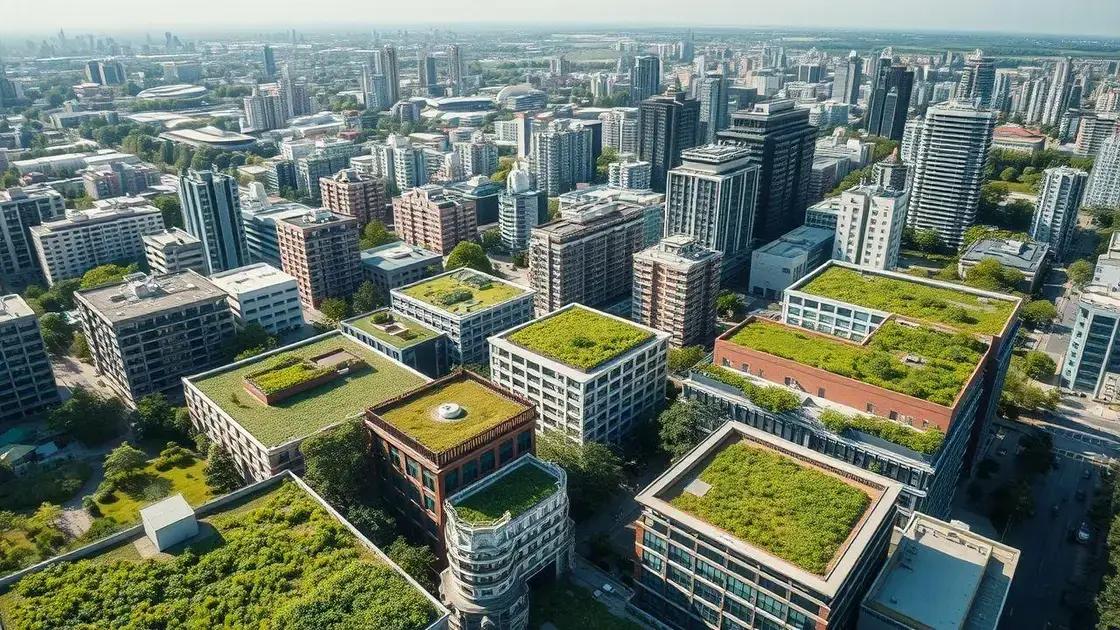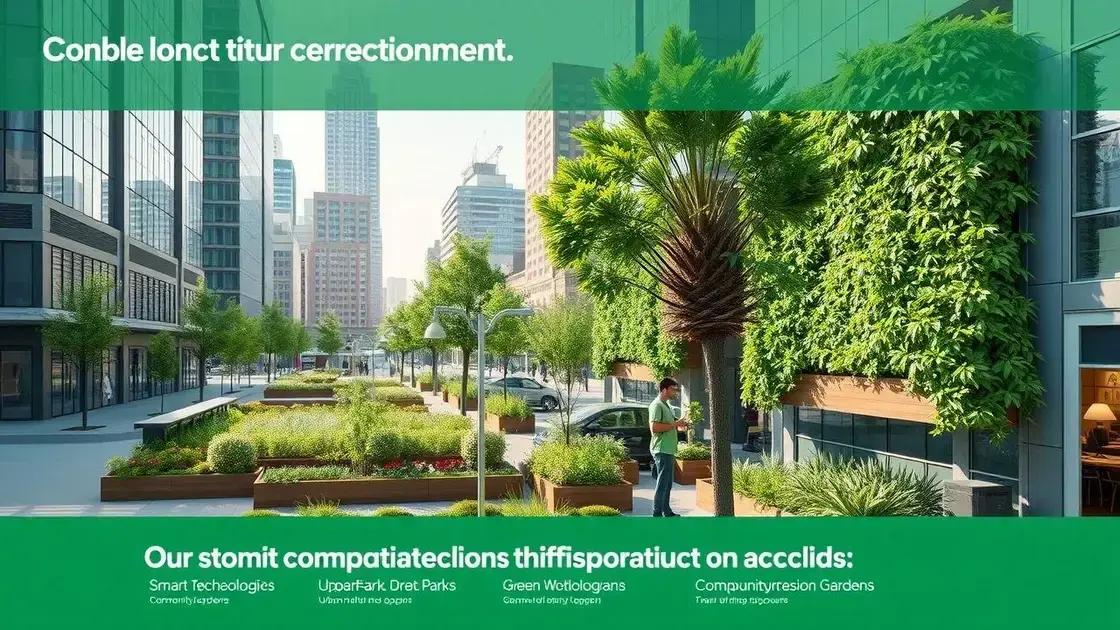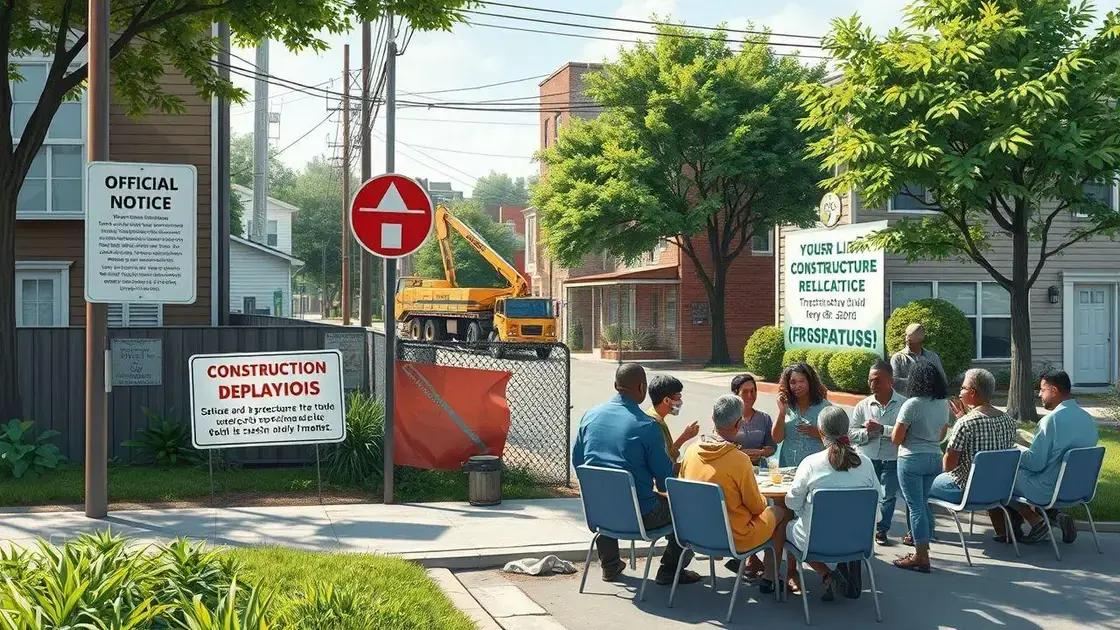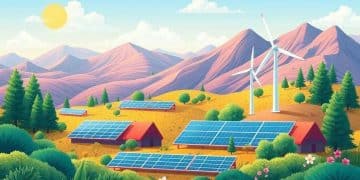Green infrastructure headlines trends shaping future cities

Green infrastructure incorporates natural systems to manage urban water, improve air quality, and support biodiversity, while addressing challenges like funding and regulatory barriers through community collaboration and education.
Green infrastructure headlines trends are paving the way for sustainable urban development. Ever wondered how these innovations could improve your city’s landscape? Let’s dive into their impact.
Understanding green infrastructure concepts
Understanding green infrastructure concepts is essential for creating sustainable urban environments. These ideas revolve around integrating natural systems into urban planning, helping cities manage water, improve air quality, and enhance overall livability.
This approach shifts the focus from traditional gray infrastructure, like concrete roads and drainage systems, to more natural solutions. By utilizing elements such as trees, wetlands, and green roofs, cities can effectively address environmental challenges.
Key Elements of Green Infrastructure
Several core components make up green infrastructure. These include:
- Green roofs: These roofs covered with vegetation help cool buildings and manage stormwater.
- Rain gardens: Designed to capture and absorb rainwater, they reduce runoff and filter pollutants.
- Permeable pavements: Allow water to infiltrate the ground, minimizing surface runoff.
- Urban forests: Trees in cities improve air quality and provide shade.
By understanding these elements, communities can better appreciate the benefits of green infrastructure. Not only does it promote biodiversity, but it also enhances recreational spaces. For example, parks and green corridors serve to unite neighborhoods while providing habitats for wildlife.
Moreover, green infrastructure plays a crucial role in combating climate change. With rising temperatures and extreme weather events becoming more common, cities must adapt. Incorporating natural features can help mitigate flooding, reduce heat island effects, and improve resilience.
Incorporating green infrastructure into city planning requires collaboration among various stakeholders. This includes city officials, environmental advocates, and the community. By working together, cities can create more sustainable and healthy environments.
Key trends in green infrastructure development

Key trends in green infrastructure development are shaping the future of cities. As sustainability becomes a priority, innovative practices and technologies emerge to meet the needs of urban environments.
One major trend is the increasing use of smart technology. This includes sensors and data analytics that help monitor natural systems. With real-time data, cities can manage resources more effectively and respond to challenges promptly.
Nature-Based Solutions
Another important trend is the focus on nature-based solutions. These involve using natural processes to tackle urban issues. For example, urban forests and green spaces enhance biodiversity and improve air quality.
- Urban parks: Providing recreational spaces while managing stormwater.
- Green walls: Vertical gardens that help cool buildings.
- River restoration: Reviving waterways to enhance ecosystems and reduce flooding risk.
- Community gardens: Promoting local food production and community engagement.
Furthermore, there is a growing emphasis on collaboration among different sectors. City planners, environmentalists, and communities are working together to develop cohesive strategies for implementing green infrastructure. This teamwork leads to more comprehensive approaches that benefit everyone.
Additionally, education and awareness play significant roles in driving these trends. As more people understand the advantages of green infrastructure, there is increased public support for these initiatives. Workshops, seminars, and community events are effective ways to spread knowledge and build enthusiasm.
Investing in green infrastructure is not just about improving aesthetics. It also provides economic benefits, such as job creation and increased property values. More cities recognize that sustainable practices can support economic growth while fostering healthier environments.
Benefits of implementing green infrastructure
The benefits of implementing green infrastructure are numerous and impactful. By prioritizing natural systems within urban planning, cities can create environments that enhance both human well-being and ecosystem health.
One key advantage is improved stormwater management. Traditional gray infrastructure often leads to flooding and pollution. In contrast, strategies like green roofs and rain gardens absorb rainfall, allowing water to return to the ground naturally.
Enhancing Biodiversity
Integrating green spaces helps to enhance biodiversity in urban areas. Natural habitats attract various species of birds, insects, and plants. This can lead to healthier ecosystems and vibrant community environments.
- Urban wildlife: Green areas provide refuge for wildlife, supporting ecological balance.
- Pollinator gardens: These spaces promote essential pollinators like bees, improving food production.
- Community engagement: Parks and gardens offer educational opportunities for people to connect with nature.
- Preserved habitats: Protecting existing green spaces contributes to preserving local flora and fauna.
Moreover, green infrastructure can significantly improve air quality. Vegetation filters pollutants, leading to cleaner air. Trees, in particular, absorb carbon dioxide and release oxygen, creating healthier living conditions for residents.
Another remarkable aspect is the potential for economic benefits. Implementing green infrastructure can increase property values and reduce health costs through improved physical environments. When people enjoy their surroundings, property demand rises, bringing higher real estate values.
Additionally, green spaces contribute to mental health. Access to nature reduces stress and promotes relaxation. Studies show that spending time outdoors enhances overall well-being, providing people with spaces for recreation and social interactions.
Challenges in adopting green infrastructure

Challenges in adopting green infrastructure can pose significant hurdles for cities and communities. Although many benefits exist, the path to implementation is often complex and requires careful planning.
One of the main challenges is funding. Many green infrastructure projects may face budget constraints, as they often require upfront investment. Cities might struggle to allocate financial resources for natural systems over traditional infrastructures.
Regulatory Barriers
Another obstacle involves regulations. Existing laws may not support innovative approaches to urban design. For example, zoning laws could restrict the use of green roofs or rain gardens.
- Bureaucratic processes: Lengthy approval times can delay projects.
- Conflicting regulations: Different departments may have varying standards for green initiatives.
- Lack of incentives: Limited motivation for developers to pursue green projects if benefits are unclear.
Moreover, public perception can also impede progress. Some community members may prefer traditional infrastructure due to familiarity. Thus, educating the public about the long-term benefits of green infrastructure becomes essential.
Additionally, maintenance can be a concern. Once green infrastructure is implemented, ongoing upkeep is vital to ensure its effectiveness. Without proper care, features like bioretention systems may fail to function, wasting initial investments.
Another notable challenge is the need for skilled professionals. Implementing and maintaining green infrastructure requires specific expertise that may not be readily available. Training and developing skilled workers is necessary to overcome this gap.
Ultimately, addressing these challenges will require collaboration among government officials, community members, and private sectors. Finding common ground and solutions can pave the way for a more sustainable future.
FAQ – Frequently Asked Questions about Green Infrastructure
What is green infrastructure?
Green infrastructure refers to natural systems and processes that manage water and enhance environmental quality in urban areas.
What are the main benefits of implementing green infrastructure?
The main benefits include improved air quality, reduced stormwater runoff, enhanced biodiversity, and increased property values.
What challenges do cities face when adopting green infrastructure?
Challenges include funding constraints, regulatory barriers, and the need for public education and engagement.
How can communities help support green infrastructure projects?
Communities can support these projects through advocacy, participating in educational programs, and getting involved in local planning efforts.





